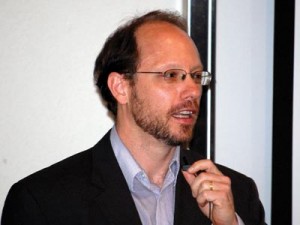Andrew Esguerra
Staff Writer

Photo: Erica Magarian
Illuminating a period of internal conflict within the Armenian faith, Professor Sergio La Porta, holder of the Haig and Isabel Berberian Chair of Armenian Studies, spoke before a sizeable audience at Fresno State on Thursday, March 22. This talk was part of the Armenian Studies Program Spring lecture series.
Delivering a lecture entitled “Knowledge, Heresy, and Inquisition: The Armenian Reaction to Latin Missionaries in the 14th century,” Dr. La Porta discussed the cultural and religious reaction of the Armenians to Roman Catholic missionaries in the fourteenth century.
Greater Armenia, the landlocked region where the current Republic of Armenia sits, was ruled by a few, prominent families at this time. Armenians there lived sandwiched between two political powers in the region, the Mamluks of Egypt and the Mongol Empire. Although Cilician Armenia had had extensive ties with the Roman Catholic since the twelfth century, Franciscan monks had started making their way into Greater Armenia only in the second half of the thirteenth. Their early attempts at spreading Catholic teaching in Armenia was followed by Dominican missionaries who quickly came to dominate the missionizing activity in the region.
Initially some Armenians were welcoming to the Latin monks. Zakaria Dzordzoretsi, the head of the monastery of St. Thaddeus, allowed the Franciscan missionaries to lecture on theology. According to statements by European travellers, Zakaria also assisted in the conversion of approximately 4,000 Armenians to Roman Catholicism.
The quick success of the Catholic missionaries alarmed some Armenian bishops such as Stepanos Orbelian, who had also criticized Cilicia’s close relationship with the Roman Catholic Church. In contemporary letters, the head of the monastic school at Gladzor, Esayi Nchetsi, cautions fellow Armenians to be wary in their dealings with Catholics and Armenians who follow their teaching; to treat them as Christians, but not to engage them in debate.
Nonetheless, the popularity of Catholic teachings continued to increase, particularly after the Papacy’s formal recognition of the Unitor Brothers, an Armenian monastic order that was fully united with Rome. Dr. La Porta questioned why so many Armenian monks were attracted to Roman Catholicism during this period. He suggested that intellectual curiosity was a primary motive. Dr. La Porta suggested that the Latin Aristotelian tradition that developed in the Dominican order during the course of the thirteenth century was extremely attractive to Armenian students who were familiar with their own Aristotelian tradition.
The Armenian Apsotolic response to the increasing successes of Roman Catholic and Armenian Catholic missionaries become more intense during the second half of thee 14th 14th century. La Porta illustrated how leading Armenian Apostolic monks launched investigations similar to the inquisition to insure that Armenians did not convert. Although these investigations do not seem to have been authorized or officially sanctioned by the Church leadership in the manner of the Inquisition in Europe, they often were violent, even fatal. Dr. La Porta observed, however, that European missionaries were never harmed and that the investigations and the violence were internal.
Despite this strong reaction against Armenians who had converted, Dr. La Porta stressed that the same people who headed the inquisitions were themselves quite knowledgeable of the Catholic literature that had been translated into Armenian. They incorporated elements of Roman Catholic literature into their own works and reformed the Armenian monastic education system along Catholic lines.
They thus changed the shape of the Armenian intellectual tradition while setting up boundaries of Armenian identity.
 Hye Sharzhoom Armenian Action
Hye Sharzhoom Armenian Action